1993 PONTIAC GRAND-AM wheel
[x] Cancel search: wheelPage 69 of 306
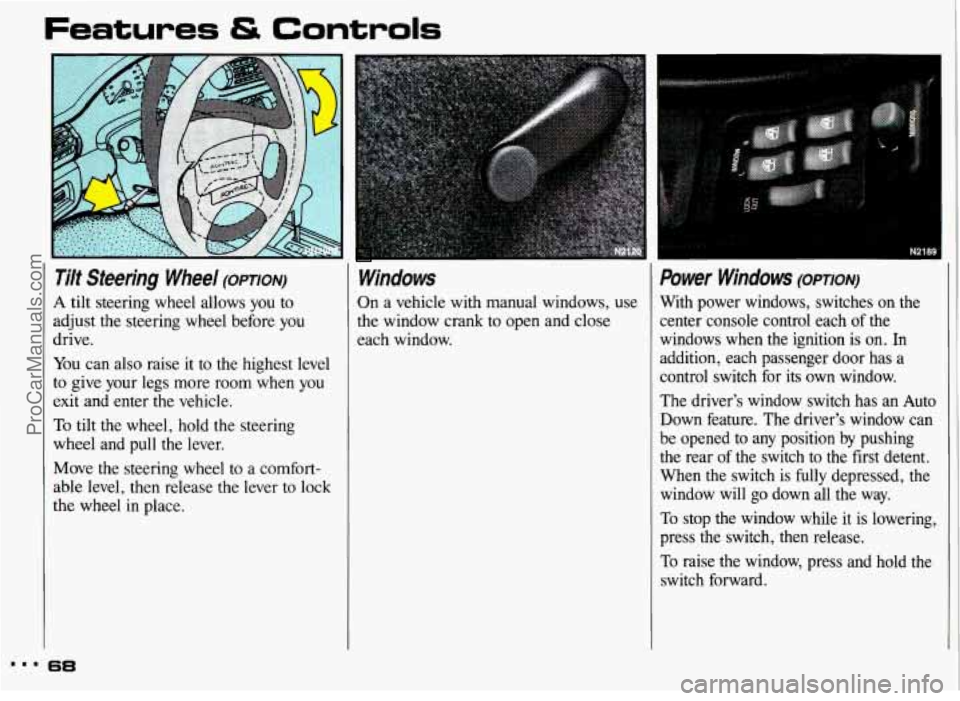
...
Features & Controls
Ti/t Steering Wheel (opTIoN)
A tilt steering wheel allows you to
adjust the steering wheel before you
drive.
You can also raise it to the highest level
to give your legs more room when
you
exit and enter the vehicle.
To tilt the wheel, hold the steering
wheel and pull the lever.
Move the steering wheel to a comfort-
able level, then release the lever to lock
the wheel in place.
38
Windows
On a vehicle with manual windows, use
the window crank to open and close
each window.
I N21
Power Windows (opTIoN)
With power windows, switches on the
center console control each of the
windows when the ignition is
on. In
addition, each passenger door has a
control switch for its own window.
The driver’s window switch has an Auto
Down feature. The driver’s window can
be opened to any position by pushing
the rear of the switch to the first detent.
When the switch is fully depressed, the
window will go down all the way.
To stop the window while it
is lowering,
press the switch, then release.
To raise the window, press and hold the
switch forward.
ProCarManuals.com
Page 71 of 306

Features & Controls
Turn Signal and Lane Change
Indicator
(CONT.)
To signal a lane change, just raise or
lower the lever until the green arrow
starts to flash. Hold it there until you
complete your lane change. The lever
will return by itself when you release
it.
As you signal a turn or a lane change, if
the arrows don’t flash but just stay on, a
signal bulb may be burned out and other
drivers won’t see your turn signal.
If a bulb is burned out, replace
it to help
avoid an accident. If the green arrows
don’t
go on at all when you signal a
turn, check the fuse (see the Index under
Fuses & Circuit Breakers) and for
burned-out bulbs.
70
Cruise Control (OPTION)
With cruise control, you can maintain a.
speed
of about 25 mph (40 km/h) or
more without keeping your foot
on the
accelerator. This can really help on long
trips. Cruise control does
not work at
speeds below about
25 mph (40 km/h).
When
you apply your brake or the
clutch pedal, the cruise control
shuts
off. I
I CAUTION
IL
A 0 Cruise control can be
dangerous where you can’t
drive safely
at a steady speed.
So, don’t use your cruise control ‘
on winding roads ofin heavy
traff1C.
I
0 Cruise control can be dangerous
on slippery roads. On such
roads, fast changes
in tire
traction can cause needless wheel
1 spinnin&and you could lose
control.
Don’t use cruise control
on slippery roads.
I
ProCarManuals.com
Page 88 of 306

The lnstrument Panel-
bur Information System
Your instrument panel is designed to let
you know at a glance how your vehicle
is running. You’ll know how fast you’re going, how much fuel you’re using, and
many other things you’ll need to drive
safely and economically.
The main components
of your
instrument panel are:
1. Fog Light Switch
2. Instrument Panel Intensity
3. Side Vent
4. Turn SignaUHeadlight Beam Lever Control/Interior Lights Switch
5. Hazard Warning Flashers Switch
6. Instrument
Cluster
7. Windshield Wiper/Washer Stalk
8. Center Vent
9. Audio System
1 0. Side Vent
1 1. Side Window Defogger Vent
12. Glove Box
1 3. Climate Control System
14. Ashtray/Lighter
15. Gear Shift Lever
16. Rear Window Defogger (Option)
17. Ignition Switch
18. Horn
1 9. Tilt Steering Wheel Lever (Option)
20. Parking Brake Release Lever
21. Hood Release Handle
22. Fuse Panel
I
ProCarManuals.com
Page 133 of 306
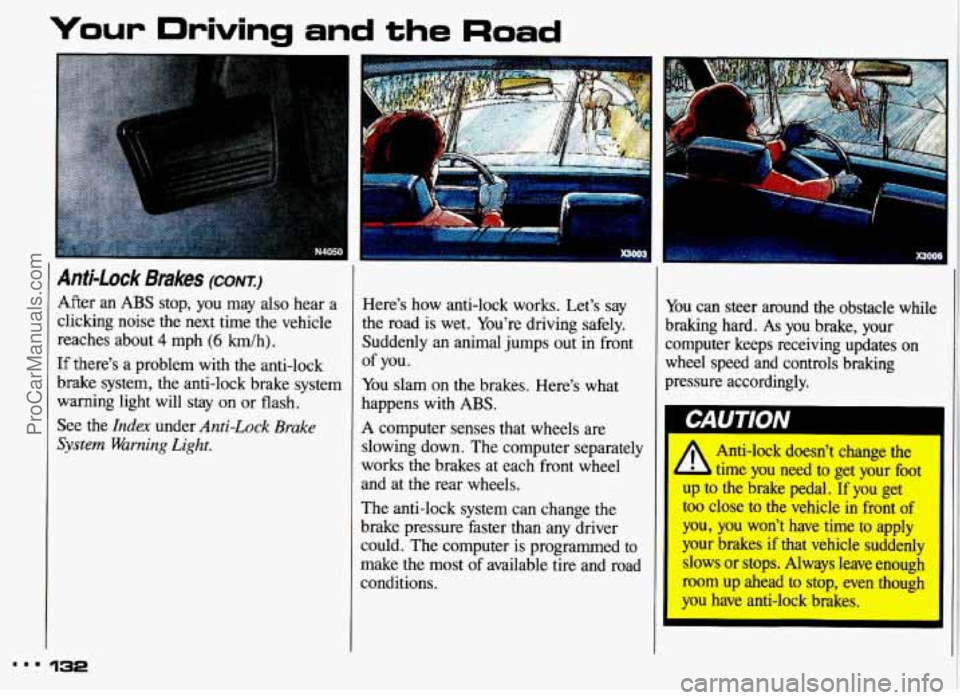
...
Your Driving and the Road
Anti-Lock Brakes (CONT.)
After an ABS stop, you may also hear a
clicking noise the next time the vehicle
reaches about
4 mph (6 km/h).
If there’s a problem with the anti-lock
brake system, the anti-lock brake system
warning light will stay
on or flash.
See the
Index under Anti-Lock Brake
System Warning Light.
132
Here’s how anti-lock works. Let’s say
the road is wet. You’re driving safely.
Suddenly an animal jumps out in front
You slam on the brakes. Here’s what
happens with ABS.
A computer senses that wheels are
slowing down. The computer separately
works the brakes at each front wheel
and at the rear wheels.
The anti-lock system can change the
of you.
brake pressure faster than any driver
could. The computer
is programmed to
make the most
of available tire and road
conditions. You
can steer around the obstacle while
braking hard.
As you brake, your
computer keeps receiving updates on
wheel speed and controls braking
pressure accordingly.
Anti-lock doesn’t change the
time you need
to get your foot
the brake pedal. If you get
too close to the vehicle in front
of
I you, you won’t have time to apply
your brakes
if that vehicle suddenly
slows or stops. Always leave enough
room up ahead to stop, even though
you have anti-lock brakes.
ProCarManuals.com
Page 137 of 306
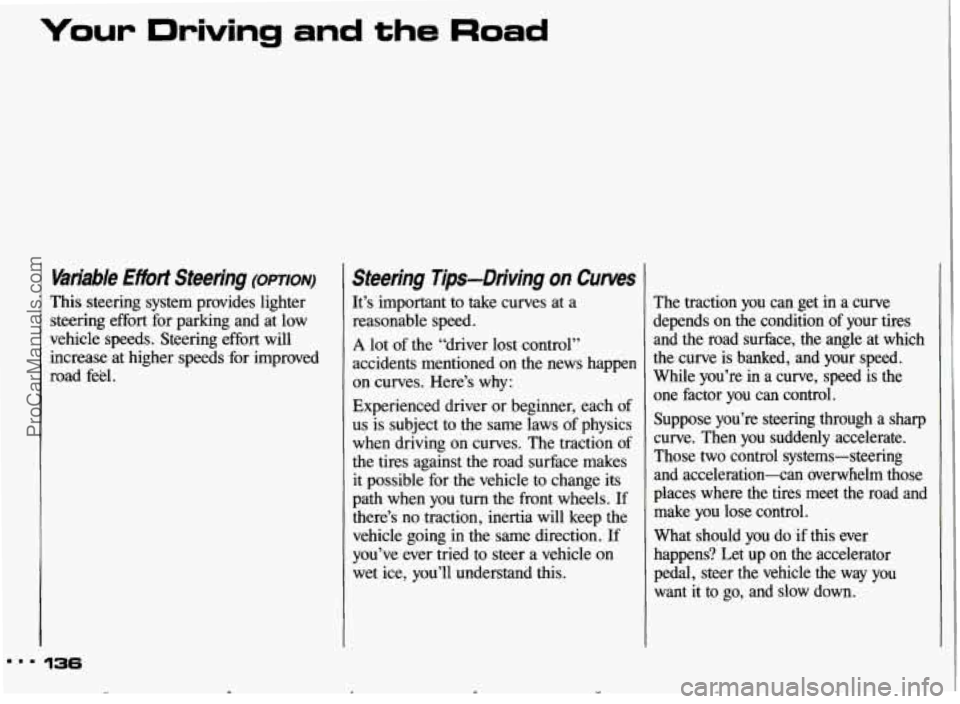
Your Driving and the Road
Variable Effort Steering (omoN)
This steering system provides lighter
steering effort for parking and at low
vehicle speeds. Steering effort will
increase at higher
speeds for improved
road feel.
Steering Tips-Driving on Curves
It’s important to take curves at a
reasonable speed.
A lot of the “driver lost control”
accidents mentioned on the
news happen
on curves. Here’s why:
Experienced driver or beginner, each
of
us is subject to the same laws of physics
when driving on curves. The traction of
the tires against the road surface makes
it possible for the vehicle to change its
path when you
turn the front wheels. If
there’s no traction, inertia will keep the
vehicle going in the same direction. If
you’ve ever tried to steer a vehicle on
wet ice, you’ll understand this. The traction
you
can get in a curve
depends on the condition of your tires
and the road surface, the angle at which
the curve is banked, and your speed.
While you’re
in a curve, speed is the
one factor you can control.
Suppose you’re steering through
a sharp
curve. Then you suddenly accelerate. Those
two control systems-steering
and acceleration-can overwhelm those
places where the tires meet the road and make you lose control.
What should you do if this ever
happens? Let up on the accelerator
pedal, steer the vehicle the way you
want it to go, and slow down.
8.8 136
ProCarManuals.com
Page 138 of 306
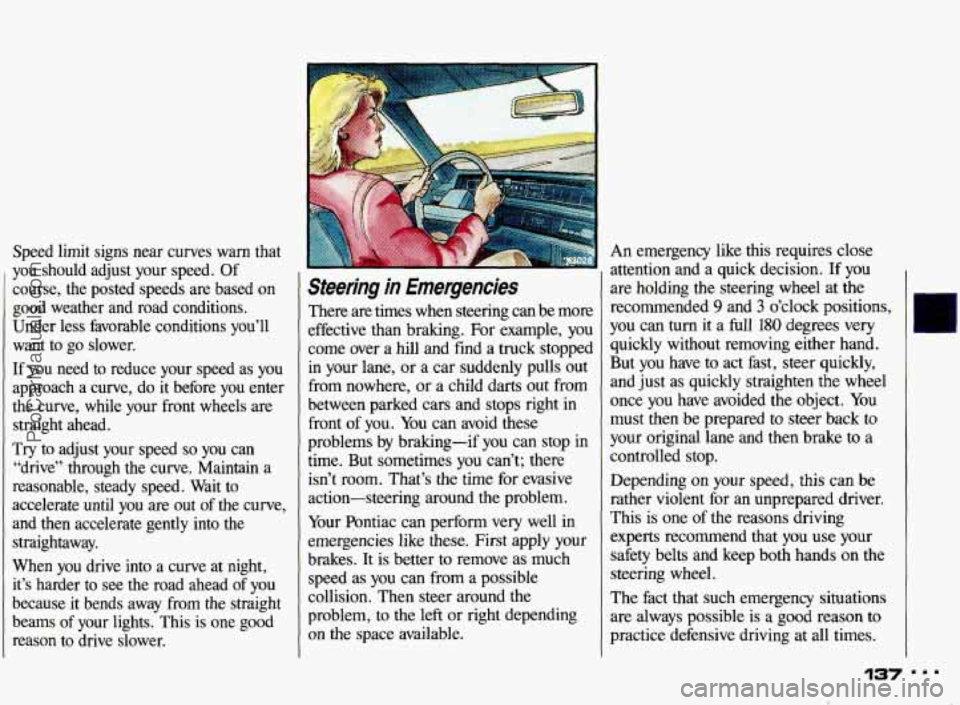
Speed limit signs near curves warn that
you should adjust your speed. Of
course, the posted speeds are based
on
good weather and road conditions.
Under less favorable conditions you’ll
want to go slower.
If you need to reduce your speed as you
approach a curve, do it before you enter
the curve, while your front wheels are
straight ahead.
Try to adjust your speed
so you can
“drive” through the curve. Maintain a
reasonable, steady speed. Wait to
accelerate until
you are out of the curve,
and then accelerate gently into the
straightaway.
When
you drive into a curve at night,
it’s harder to see the road ahead of you
because it bends away from the straight
beams of your lights. This is one good
reason to drive slower.
Steering in Emergencies
There are times when steering can be more
effective than braking. For example, you
come over a hill and find a truck stopped
in your lane, or a car suddenly pulls out
from nowhere, or a child darts out from
between parked cars and stops right in
front of you.
You can avoid these
problems by braking-if
you can stop in
time. But sometimes you can’t; there
isn’t
room. That’s the time for evasive
action-steering around the problem.
Your Pontiac can perform very well in
emergencies like these. First apply your
brakes. It is better to remove as much
speed as you can from a possible
collision. Then steer around the
problem, to the left or right depending
on the space available. An emergency like this requires
close
attention and
a quick decision. If you
are holding the steering wheel at the
recommended
9 and 3 o’clock positions,
you can turn it a
full 180 degrees very
quickly without removing either hand.
But
you have to act fast, steer quickly,
and just as quickly straighten the wheel
once
you have avoided the object. You
must then be prepared to steer back to
your original lane and then brake to a
controlled stop.
Depending on your speed, this can
be
rather violent for an unprepared driver.
This is one of the reasons driving
experts recommend that
you use your
safety belts and keep both hands on the
steering wheel.
The fact that such emergency situations
are always possible is a good reason to
practice defensive driving at all times.
ProCarManuals.com
Page 139 of 306

Your Driving and the Road
Off-Road Recovery
You may find sometime that your right
wheels have dropped off the edge of a
road onto the shoulder while you're
driving.
If the level of the shoulder is only
slightly below the pavement, recovery
should be fairly easy. Ease off the
accelerator and then, if there is nothing
in the way, steer
so that your vehicle
straddles the edge of the pavement. You
can turn the steering wheel up
to 94 turn
until the right front tire contacts the
pavement edge. Then turn your steering
wheel to go straight down the roadway.
If the shoulder appears
to be about four
inches
(100 mm) or more below the
pavement, this difference can cause
problems.
If there is not enough room to pull
entirely onto the shoulder and stop,
then follow the same procedures. But
if
the right front tire scrubs against the
side of the pavement, do
not steer more
sharply. With too much steering angle,
the vehicle may jump back onto the road
with
so much steering input that it
crosses over into the oncoming traffic
before you can bring
it back under
control. Instead, ease off again on the
accelerator and steering input, straddle
the pavement once more, then try again.
Passing
The driver of a vehicle about to pass
another on a two-lane highway waits for
just
the right moment, accelerates,
moves around the vehicle ahead, then
goes back into the right lane again.
A
simple maneuver?
Not necessarily! Passing another vehicle
on a two-lane highway
is a potentially
dangerous move, since the passing
vehicle occupies the same lane as oncoming traffic for several seconds.
A
miscalculation, an error in judgment, or
a brief surrender to frustration or anger
can suddenly put the passing driver face
to face with the worst of all traffic
accidents-the head-on collision.
I.. 138
ProCarManuals.com
Page 142 of 306
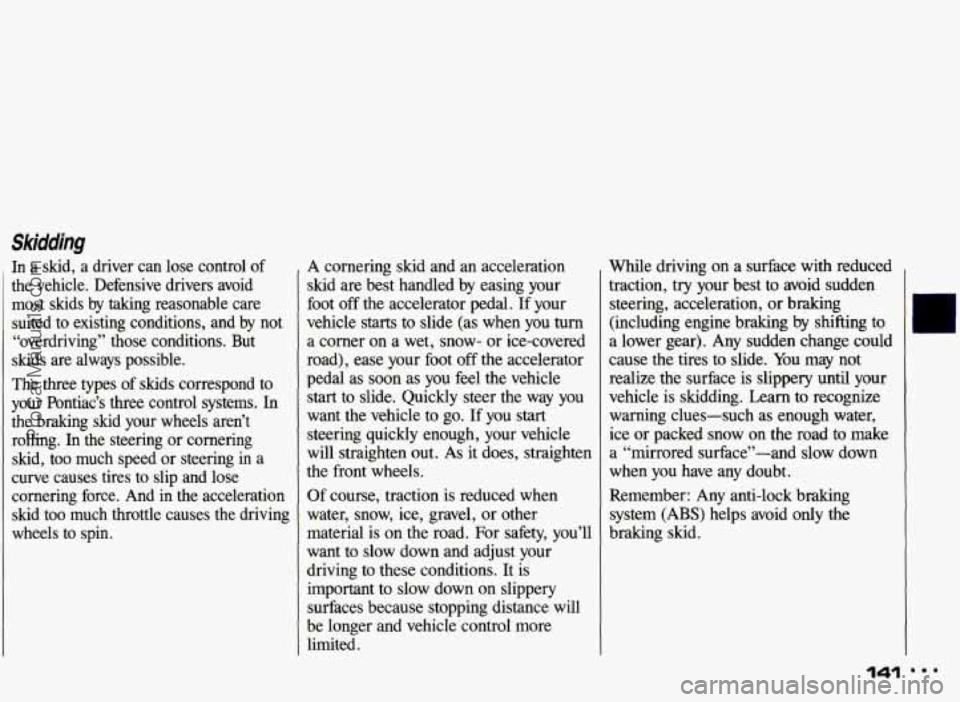
Skidding
In a skid, a driver can lose control of
the vehicle. Defensive drivers avoid
most skids by taking reasonable care
suited to existing conditions, and by not
“overdriving” those conditions. But
skids are always possible.
The three types of skids correspond to
your Pontiac’s three control systems.
In
the braking skid your wheels aren’t
rolling.
In the steering or cornering
skid, too much speed or steering in a
curve causes tires to slip and lose cornering force. And in the acceleration
skid too much throttle causes the driving
wheels to spin. A
cornering skid and an acceleration
skid are best handled by easing your
foot
off the accelerator pedal. If your
vehicle starts to slide (as when you turn
a corner on a wet, snow- or ice-covered
road), ease your foot off the accelerator
pedal as soon as you feel the vehicle
start to slide. Quickly steer the way you
want the vehicle to go.
If you start
steering quickly enough, your vehicle
will straighten out. As it does, straighten
the front wheels.
Of course, traction is reduced when
water, snow, ice, gravel, or other
material is on the road. For safety, you’ll
want to slow down and adjust your
driving to these conditions. It is
important to slow down on slippery surfaces because stopping distance will
be longer and vehicle control more
limited. While driving on
a surface with reduced
traction, try your best to avoid sudden
steering, acceleration, or braking
(including engine braking by shifting to
a lower gear). Any sudden change could
cause the tires to slide.
You may not
realize the surface is slippery until your
vehicle is skidding. Learn to recognize
warning clues-such as enough water,
ice or packed snow
on the road to make
a “mirrored surface”-and slow down
when you have any doubt.
Remember: Any anti-lock braking
system
(ABS) helps avoid only the
braking skid.
141
ProCarManuals.com